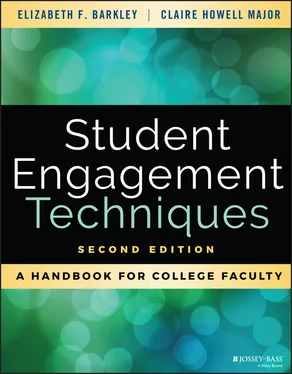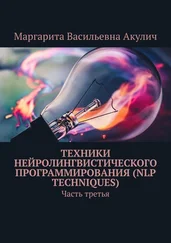Elizabeth F. Barkley - Student Engagement Techniques
Здесь есть возможность читать онлайн «Elizabeth F. Barkley - Student Engagement Techniques» — ознакомительный отрывок электронной книги совершенно бесплатно, а после прочтения отрывка купить полную версию. В некоторых случаях можно слушать аудио, скачать через торрент в формате fb2 и присутствует краткое содержание. Жанр: unrecognised, на английском языке. Описание произведения, (предисловие) а так же отзывы посетителей доступны на портале библиотеки ЛибКат.
- Название:Student Engagement Techniques
- Автор:
- Жанр:
- Год:неизвестен
- ISBN:нет данных
- Рейтинг книги:3 / 5. Голосов: 1
-
Избранное:Добавить в избранное
- Отзывы:
-
Ваша оценка:
- 60
- 1
- 2
- 3
- 4
- 5
Student Engagement Techniques: краткое содержание, описание и аннотация
Предлагаем к чтению аннотацию, описание, краткое содержание или предисловие (зависит от того, что написал сам автор книги «Student Engagement Techniques»). Если вы не нашли необходимую информацию о книге — напишите в комментариях, мы постараемся отыскать её.
— — — —
Student Engagement Techniques
"Student Engagement Techniques
"Student Engagement Techniques
"This book is an essential resource for faculty seeking to better engage with their students. Anyone seeking a clear, research-based, and actionable guide needs a copy of Student Engagement Techniques on their shelf!"
Student Engagement Techniques — читать онлайн ознакомительный отрывок
Ниже представлен текст книги, разбитый по страницам. Система сохранения места последней прочитанной страницы, позволяет с удобством читать онлайн бесплатно книгу «Student Engagement Techniques», без необходимости каждый раз заново искать на чём Вы остановились. Поставьте закладку, и сможете в любой момент перейти на страницу, на которой закончили чтение.
Интервал:
Закладка:
There are many different devices or behaviors that can help learners acquire and integrate new information with existing knowledge as well as retrieve stored information. These strategies include previewing, summarizing, paraphrasing, imaging, creating analogies, note taking, and outlining. Most experienced learners use strategies such as these to keep their attention focused on the task and their minds actively engaged. These strategies are not necessarily known or used by novice learners. We know, for example, that for new learning to take place, it has to be related to what the learner already knows. The challenge for some students—particularly underachieving students—is that existing knowledge is poorly organized and distressingly sparse. Cross (1993c) offers the analogy of a clothes closet. It is rather easy to hang clothes in a well-organized closet and retrieve them in usable form. Shoes, whether running shoes or dress shoes, have something in common and go on the floor; blouses and shirts are short and can use abbreviated hanging space; some things, such as slacks, go on special hangers; while other items such as sweaters and knits are probably best folded and placed on shelves. The point is that adding and retrieving items is easy when you understand and implement the organizing principles of the closet. If, on the other hand, you just throw things into the closet every which way (cramming it in and shutting the door quickly in the hopes that nothing will spill out!), then it will be a challenge to find the shirt you are looking for, or you might find only one of the socks.
Each schema changes and grows throughout life as new events, filtered by perception into the schema, are organized and connected to the existing structure to create meaning. Thus, new information results in meaningful learning only when it connects with what already exists in the mind of the learner, resulting in change in the networks that represent our understandings.
Transfer
When activating prior learning to make sense of something new, the brain searches for any past learnings that are similar to, or associated with, the new learning. If the experiences exist, the corresponding neuronal networks or schema are activated, reinforcing the already-stored information as well as assisting in interpreting and assigning meaning to the new information. Svinicki (2004) notes that there are many types of transfer discussed in the literature, but two types are the most important for purposes of instruction (p. 99). The first is positive versus negative transfer. If the connections are accurate, the search results in “positive” transfer that can aid the learner in understanding and integrating new learnings. If, on the other hand, the connections are incorrect, the result is negative transfer, which creates confusion and errors. For example, when teaching Romance languages to English speakers, teachers frequently encounter positive transfer (e.g., “mucho” in Spanish sounds similar to “much” in English) and negative transfer (“librairie” in French sounds like “library,” but means “bookstore”) (Sousa, 2006, pp. 138–139).
The second type of transfer is near versus far transfer. This distinction refers to the type of task: near transfer tasks are those that look very much alike and follow the same rules for responding, while a far transfer task is where the same rules apply, but they are transferred to a different setting. “Far transfer” requires more thinking on the part of the learner. Svinicki (2004) offers driving a midsize automatic sedan as an example: if you've driven one, you can easily drive any other because the steering wheel, gear shift, windshield wipers, and turn signals all look alike and are in the same position. If, on the other hand, you get into a car that is very different (such as a convertible, stick-shift sports car), your normal driving responses are not instantly triggered and you have to stop and figure out where everything is. The rules are the same, but the car looks different. Moving between different midsize automatic sedans is a near transfer task; moving from a mid-level automatic sedan to a stick-shift sports car is a far transfer task (Svinicki, 2004, pp. 100–101). There are several factors that affect the quality of transfer: similarity/difference, association, and context and degree of original learning.
Similarity and Differences
How similar a previously encountered situation is to a new situation affects transfer. Interestingly, it appears that the brain generally stores new information in networks that contain similar characteristics or associations, but it retrieves information by identifying how the information is different from the other items in that network. For example, the visual appearances of people we know seem to be stored in the network of what humans look like (e.g., torso, head, two arms, two legs), but if we are trying to find someone we know in a crowd, we will look for the characteristics that distinguish them from other people in the group (e.g., facial characteristics, height, voice, and so forth). Obviously when there is high similarity with few differences, distinguishing between the two becomes more difficult (Sousa, 2006, p. 143). Thus, the potential for negative transfer is higher when concepts, principles, and data, or the labels for this information, are similar. For example, in music, “whole tone” and “whole note” sound similar, but the terms represent very different concepts (whole tone is a specific distance between two pitches, while whole note is the rhythmic duration of a single pitch).
Association
Learning two items together such that the two are bonded or associated also affects transfer, and when one of the items is recalled, the other is spontaneously recalled as well. When we hear or read “Romeo,” we unconsciously add “and Juliet,” or when we think of trademark symbols such as McDonald's golden arches or Apple's apple logo, we immediately think of the associated product (Sousa, 2006, p. 145). Since everything we know and understand is preserved as a network of associations, the more associations we make, the greater the number of potential places we have to attach new information and the easier it is for us to learn and retain that information. In short, the more we learn and retain, the more we can learn and retain.
Context and Degree of Original Learning
Emotional associations can have a particularly potent influence on transfer, as emotions usually have a higher priority than cognitive processing for commanding our attention. Words such as “abortion,” “torture,” and “terrorist” often evoke strong emotional responses. Math anxiety—the fear and tension that interferes with some students' ability to manipulate numbers or solve mathematical problems—is an example of the association of a negative feeling with a content area. Students with math anxiety will try to avoid situations involving math in order to spare themselves the negative feelings associated with it. In contrast, people will devote hours on hobbies because of the feelings of pleasure and satisfaction they associate with these activities (Sousa, 2006, p 145).
Not surprisingly, the quality of the original learning also strongly influences the quality of transfer to new learning. If the original learning was thorough, deep, and accurate, its influence will be much more constructive than learning that was originally superficial. At the college level, we work with the cumulative “prior learning” of K–12, over which we have little control. Because we have greater control over what students learn when they are with us in college (especially at the department/degree level), we should take extra care to help students connect positive feelings to new learnings and ensure that foundational material is taught well, as everything that is learned in these courses becomes the basis for future transfer.
Читать дальшеИнтервал:
Закладка:
Похожие книги на «Student Engagement Techniques»
Представляем Вашему вниманию похожие книги на «Student Engagement Techniques» списком для выбора. Мы отобрали схожую по названию и смыслу литературу в надежде предоставить читателям больше вариантов отыскать новые, интересные, ещё непрочитанные произведения.
Обсуждение, отзывы о книге «Student Engagement Techniques» и просто собственные мнения читателей. Оставьте ваши комментарии, напишите, что Вы думаете о произведении, его смысле или главных героях. Укажите что конкретно понравилось, а что нет, и почему Вы так считаете.












